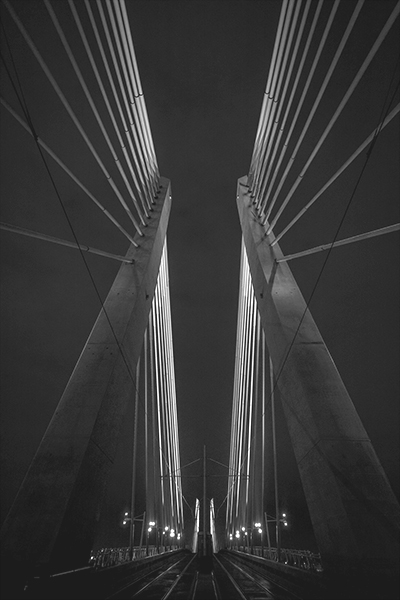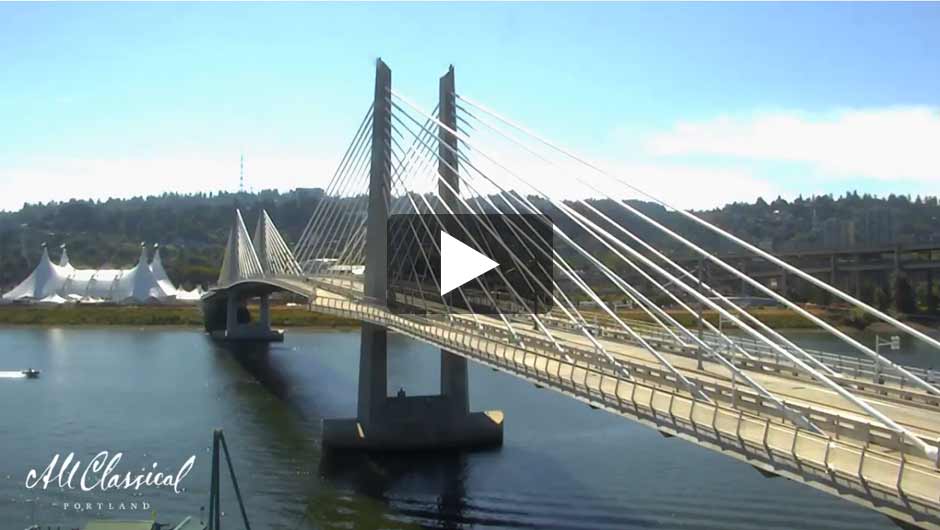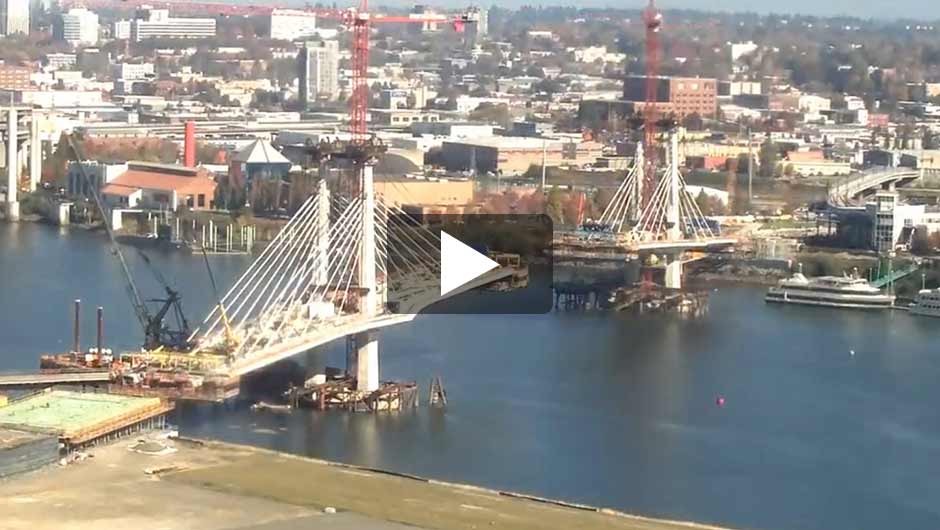TILIKUM CROSSING
Bridge of the People

The first bridge of its kind in the U.S., Tilikum Crossing, Bridge of the People, carries MAX Orange Line trains, buses, streetcars, cyclists and pedestrians over the Willamette River in Portland, Ore.
About the bridge
Tilikum Crossing adds capacity to the transportation system, with better access to important destinations such as PSU, OHSU, the Central Eastside and OMSI, while reducing commute pressure on other bridges.
Bus lines FX2-Division, 9-Powell Blvd, 17-Holgate/Broadway and 19-Woodstock/Glisan use the bridge, reducing their travel time and improving efficiency. Cyclists and pedestrians can access existing and planned greenways and bike routes on both sides of the river.
Tilikum Crossing from Dronescape Media Consulting.
- Opened September 12, 2015
- The first span over the Willamette River in the Portland area since the Fremont Bridge in 1973
- 4-pier cable-stayed bridge type (two piers on land, two in the water at the towers)
- Approximately 1,720 feet in length
- 2 towers, each 180 feet high
- 75.5 feet wide (110.5 feet at the towers)
- About 3.5 miles of cable
- 14-foot-wide path for cyclists and pedestrians (one on each side)
- 25 m.p.h. maximum speed for buses and trains
- For transit, pedestrian and cyclist use only

What’s in a name?
“Tilikum” is Chinook Wawa, an international language used by first Oregonians, and later spoken by explorers, fur traders, settlers and the first few generations of Portlanders. (In fact, it’s still spoken today!) Tilikum means “people,” “tribe” and “relatives,” and has come to describe friendly people and friends.
The Bridge Naming Committee reviewed nearly 9,500 submissions to find those that would connect and inspire — not just now, but 100 years from now — and best reflect the region’s history and culture.
Committee Chair and historian Chet Orloff said the Native American name was selected because it holds the “most promise to connect the people of our region today with the long past of people who have been here for thousands of years, and to connect with future generations.”
“Tilikum symbolizes coming together. It conveys connections, in not only the relationships between people, but in the connections we will make as we ride, walk, run and cycle across this beautiful new bridge.
— Chet Orloff, naming committee chair and historian
While the spelling “Tillicum” was initially proposed, the Committee selected “Tilikum” because that’s how the first people who lived here spelled the word.
Other finalists were the Abigail Scott Duniway Bridge, the Cascadia Crossing Transit Bridge, and the Wy’east Transit Bridge.

Fun Fact
Chinookans are indigenous peoples and tribes who have lived near the Columbia and Willamette rivers for 14,000 years. However, Chinook jargon is not the language of any one tribe. The jargon was developed to help native peoples communicate across distinct languages and dialects, and later was used to communicate with explorers, fur traders and settlers. More…
Tens of thousands of Native Americans lived and traveled along the Willamette River, then called the Multnomah. Most were from the many Kalapuyan nations, including the Tualatin, Santiam and Yamhill. Other tribes from the region, including the Clackamas at Willamette Falls and the Molalla from the Cascades, traded with the Kalapuyans along the river.
Native peoples were the first of millions of people to rely on the Willamette for food, transportation, recreation, trade and more. Captain William Clark entered the river in 1806, followed by more than 50,000 fur traders, pioneers and missionaries.
By the 1840s, Milwaukie, Oregon City and Portland had sprung up along the Willamette. Wheat, produce and even gold flowed down what quickly became a vital river of commerce.
Today, nearly seven in 10 Oregonians live within 20 miles of the Willamette River, which continues to serve as a center for commerce, as well as recreation and transportation.
Form + function
Tilikum Crossing has a “cable-stayed” design, with two piers in the water and two on land. A cable-stayed bridge is a bridge that consists of one or more towers through which cables are strung to support the bridge deck.
Cable-stayed bridge types are efficient at spanning long distances while minimizing the number of piers in the water. They can also be designed with thinner decks than other bridge types, allowing a more transparent structure and more vertical navigation clearance.
The bridge’s walking/biking paths are extra wide on the outside of the two towers, so you can stop and enjoy the panoramic views!
Aesthetic Lighting
As part of TriMet’s public art program for the new Orange Line, artists Anna Valentina Murch and Doug Hollis created an aesthetic lighting program for the new bridge. Lights focused on the cables and piers will fluctuate in response to a stream flow monitor in the Willamette River, echoing the river movement below.
- There are 178 LED lights aesthetically placed on 40 bridge cables, the four transmission towers above and below the deck, and on the Sonic Dish artwork along the Eastside Esplanade and future Willamette Greenway at the ends of the bridge
- The lights change colors based on the Willamette River’s speed, height and water temperature
- This data is collected by a U.S. Geological Survey river monitor near the Morrison Bridge
- Specialized software designed by programmer Morgan Barnard takes that data and translates it into movements of color and light across the bridge.
- The water temperature determines the base color
- The river’s speed controls the pace the colors change and move across the bridge
- The river’s height is displayed by a second color that moves vertically up and down the towers and the cables
Construction timelapse videos
Getting to the Bridge
The best way to experience Portland’s newest landmark is, of course, to take transit, walk or bike to Tilikum Crossing. MAX Orange Line trains, bus lines FX2-Division 9, 17, 19 and Portland Streetcar offer frequent service to the bridge.
Driving?
If you plan to drive to the bridge, keep in mind on-street parking in the nearby South Waterfront and Central Eastside districts is limited.










